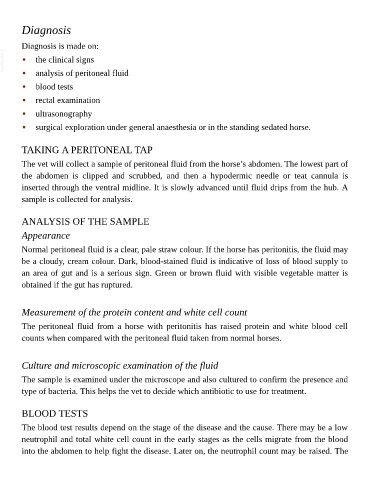Page 800 - The Veterinary Care of the Horse
P. 800
Diagnosis
Diagnosis is made on:
VetBooks.ir • the clinical signs
• analysis of peritoneal fluid
• blood tests
• rectal examination
• ultrasonography
• surgical exploration under general anaesthesia or in the standing sedated horse.
TAKING A PERITONEAL TAP
The vet will collect a sample of peritoneal fluid from the horse’s abdomen. The lowest part of
the abdomen is clipped and scrubbed, and then a hypodermic needle or teat cannula is
inserted through the ventral midline. It is slowly advanced until fluid drips from the hub. A
sample is collected for analysis.
ANALYSIS OF THE SAMPLE
Appearance
Normal peritoneal fluid is a clear, pale straw colour. If the horse has peritonitis, the fluid may
be a cloudy, cream colour. Dark, blood-stained fluid is indicative of loss of blood supply to
an area of gut and is a serious sign. Green or brown fluid with visible vegetable matter is
obtained if the gut has ruptured.
Measurement of the protein content and white cell count
The peritoneal fluid from a horse with peritonitis has raised protein and white blood cell
counts when compared with the peritoneal fluid taken from normal horses.
Culture and microscopic examination of the fluid
The sample is examined under the microscope and also cultured to confirm the presence and
type of bacteria. This helps the vet to decide which antibiotic to use for treatment.
BLOOD TESTS
The blood test results depend on the stage of the disease and the cause. There may be a low
neutrophil and total white cell count in the early stages as the cells migrate from the blood
into the abdomen to help fight the disease. Later on, the neutrophil count may be raised. The

